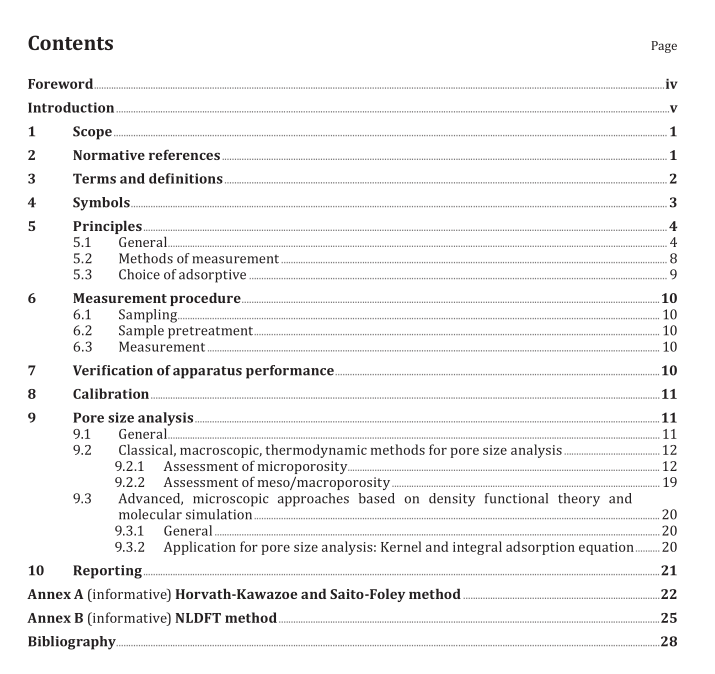ISO 15901-2 pdf download

ISO 15901-2 pdf download Pore size distribution and porosity of solid materials by mercury porosimetry and gas adsorption — Part 2: Analysis of nanopores by gas adsorption
1Scope
This document describes a method for the evaluation of porosity and pore size distribution by physicaladsorption (or physisorption). The method is limited to the determination of the quantity of a gasadsorbed per unit mass of sample as a function of pressure at a controlled, constant temperaturel1-2].Commonly used adsorptive gases for physical adsorption characterization include nitrogen, argon,krypton at the temperatures of liquid nitrogen and argon (77 Kand 87K respectively) as well as Co (at273K).Traditionally, nitrogen and argon adsorption at 77Kand 87K, respectively, allows one to assesspores in the approximate range of widths 0,45 nm to 50 nm, although improvements in temperaturecontrol and pressure measurement allow larger pore widths to be evaluated.CO2adsorption at273K-293Kcan be applied for the microporous carbon materials exhibiting ultramicropores.Kryptonadsorption at 77 K and 87 K is used to determine the surface area or porosity of materials with smallsurface area or for the analysis of thin porous films.
The method described is suitable for a wide range of porous materials. This document focuses onthe determination of pore size distribution from as low as 0,4 nm up to approximately 100 nm.Thedetermination of surface area is described in lSO 9277.The procedures which have been devised for thedetermination of the amount of gas adsorbed may be divided into two groups:
– those which depend on the measurement of the amount of gas removed from the gas phase, i.e.
manometric (volumetric) methods;
those which involve the measurement of the uptake of the gas by the adsorbent (i.e. directdetermination of increase in mass by gravimetric methods).
In practice, static or dynamic techniques can be used to determine the amount of gas adsorbed. However,the static manometric method is generally considered the most suitable technique for undertakingphysisorption measurements with nitrogen, argon and krypton at cryogenic temperatures (i.e.77Kand 87 K, the boiling temperature of nitrogen and argon, respectively) with the goal of obtaining porevolume and pore size information.This document focuses only on the application of the manometricmethod.
2Normative references
The following documents are referred to in the text in such a way that some or all of their contentconstitutes requirements of this document.For dated references,only the edition cited applies. Forundated references, the latest edition of the referenced document (including any amendments) applies.ISO 3165,Sampling of chemical products for industrial use — Safety in sampling
ISO 8213,Chemical products for industrial use —Sampling techniques — Solid chemical products in theform of particles varying from powders to coarse lumps
ISO 9277,Determination of the specific surface area of solids by gas adsorption — BET method
ISO 14488,Particulate materials — Sampling and sample splitting for the determination of particulateproperties
3? Terms? and? definitions
For the purposes of this document, the following terms and definitions apply.
ISO and IEC maintain terminological databases for use in standardization at the following addresses:
— ISO Online browsing platform: available at https:// www .iso .org/ obp
— IEC Electropedia: available at https:// www .electropedia .org/
3.1
adsorbate
adsorbed gas
3.2
adsorption
enrichment of the adsorptive at the external and accessible internal surfaces of a solid
3.3
adsorptive
gas or vapour to be adsorbed
3.4
adsorbent
solid material on which adsorption occurs
3.5
adsorption isotherm
relationship between the amount of gas adsorbed and the equilibrium pressure of the gas at constant
temperature
3.6
adsorbed amount
amount of gas adsorbed at a given pressure, p, and temperature, T
3.7
equilibrium adsorption pressure
pressure of the adsorptive in equilibrium with the adsorbate
3.8
monolayer amount
amount of the adsorbate that forms a monomolecular layer over the surface of the adsorbent
3.9
monolayer capacity
volumetric equivalent of monolayer amount expressed as gas at standard conditions of temperature
and pressure (STP)
3.10
nanopore
pore with width of 100 nm or less
3.11
macropore
pore with width greater than about 50 nm
3.12
mesopore
pore with width between approximately 2 nm and 50 nm









